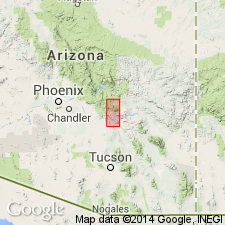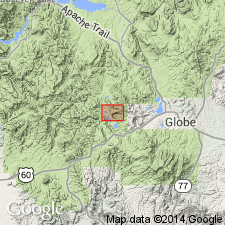
- Usage in publication:
-
- Tornado limestone*
- Modifications:
-
- Named
- Dominant lithology:
-
- Limestone
- AAPG geologic province:
-
- Basin-and-Range province
Summary:
Named for Tornado Peak, southeast part of Ray quad, Gila Co, AZ in the Basin-and-Range province where it is mapped (geologic map) with the Martin limestone. No type locality designated. Conformably overlies Martin limestone. Is equivalent to the Carboniferous portion of the Globe limestone. Upper contact is erosional. Geologic map; mapped in Dripping Spring Range in south-central part of region and in northern part of area, Gila and Pinal Cos. Consists of gray limestone. Has a lower 75 ft thick massive bed, a middle massive 100 ft thick unit, and an upper thinner bedded part whose thickness was not stated. A few thin layers of calcareous shale. Is about 1,000 ft thick. Fossils (crinoids, corals, brachiopods) listed of Mississippian and Pennsylvanian age. Of marine origin.
Source: GNU records (USGS DDS-6; Denver GNULEX).

- Usage in publication:
-
- Tornado limestone*
- Modifications:
-
- Not used
Summary:
Included beds now assigned to the Mississippian Escabrosa limestone and to the Pennsylvanian lower part of the Naco limestone.
Source: GNU records (USGS DDS-6; Denver GNULEX).
For more information, please contact Nancy Stamm, Geologic Names Committee Secretary.
Asterisk (*) indicates published by U.S. Geological Survey authors.
"No current usage" (†) implies that a name has been abandoned or has fallen into disuse. Former usage and, if known, replacement name given in parentheses ( ).
Slash (/) indicates name conflicts with nomenclatural guidelines (CSN, 1933; ACSN, 1961, 1970; NACSN, 1983, 2005, 2021). May be explained within brackets ([ ]).

